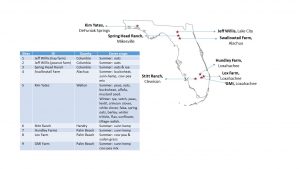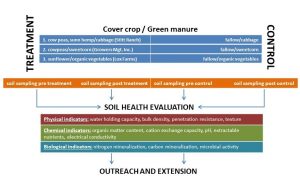Final report for OS18-114
Project Information
Cover crops are proving to be vital in the development of soil health. Growing cover crops is perhaps the most valuable strategy we can adopt to feed our soil, build up its fertility, and improve its structure with each passing season. Green manure is a cover crop used primarily as a soil amendment and a nutrient source for subsequent crops. In most production environments, lack of nitrogen limits plant growth more than any other nutrient. Legumes, however, possess a symbiotic relationship with rhizobial bacteria capable of transforming atmospheric N2 into plant usable form and may accumulate large amounts of N via this pathway. Legumes utilized as green manure therefore represent a potentially renewable source of on-farm, biologically fixed N. Unlike chemical N fertilizers, legumes may also fix and add large amounts of carbon to a cropping system. Green manure approaches may also drive long-term increases of soil organic matter and microbial biomass, further improving nutrient retention and N-uptake efficiency. When used in place of fallow, well-chosen green manures may reduce erosion and suppress weeds and specific crop pests. Green manures may also offer habitat or resources for beneficial organisms. All of these processes are quintessential for improving soil quality.
We propose evaluating sunn hemp (Crotalaria juncea) and cowpeas (Vigna unguiculata) as two green manure options that would perform well in Florida during summer.
The research approach comprises of the following four tasks:
- Identification and commitment from cooperative growers;
- Study design;
- Soil testing and analyses;
- Assisting growers adopt cover cropping practice
Cooperators
- (Educator and Researcher)
- (Educator and Researcher)
- (Researcher)
- (Educator and Researcher)
- (Educator and Researcher)
Research
The purpose of this project was to identify growers within Florida that practiced cover cropping during the fallow period. Due to the climatic variability within the state from North to South, in south Florida the fallow period is usually summer month, while in north Florida winter months are usually fallow. As part of this study we were able to identify 8 collaborative growers across the state, representing 9 unique farming programs. The common denominator being that they all cover crop during the fallow period.
Once we had identified the growers, we wanted to shadow their practice and collect soil samples before and after their cover cropping program, to evaluate the change in soil health properties as a function of cover cropping.


Educational & Outreach Activities
Participation Summary:
As part of our Education and Outreach program, we have had at least 20 consultations with our collaborative farmers. These consultations typically are held at their farms and last about an hour. The educational tool that was developed in the last year was a six-module In-service training (IST) comprising of presentations and hands-on demonstrations on the topic of soil health and sustainability. Two such training was provided to the agricultural professionals, particularly extension agents and extension specialists. The topics covered included subjects like soil health principles, soil microbiology, soil health indicators, benefits of cover cropping etc. This IST is now also available online for agricultural professionals to take remotely. In 2018, we compiled a Soil Health and Sustainability Handbook, that will be distributed to all our project collaborators.
Our future planned activity includes conducting a training in 2019 for the growers on the topic of soil health and sustainability and also publish an extension article on the topic of cover cropping during fallow period.
Learning Outcomes
Soil fertility/nutrient status
Cation exchange capacity of the soil
Water holding capacity of the soil
Organic matter content
Soil health indicators
Project Outcomes
As part of the first year of this project we had six collaborative growers on whose farms we were able to get both pre and post cover cropping soil samples. We were also able to identify one new Extension agent, and two additional growers (3 sites) that wish to participate in this study during year two. Results indicate that 2/6 farms showed a reduction in bulk density (BD), 3/6 showed an increase in BD, whereas 1/6 farm showed no change in BD. Soil pH reduced in 4/6 farms, whereas 2/6 farms showed an increase in soil pH. 5/6 farms showed an increase in maximum water holding capacity (MWHC) of the soil, whereas only 1/6 farm showed a decrease in MWHC. 4/6 farms showed an increase in organic matter (OM), whereas 2/6 farms showed a decrease in OM content. All 6/6 farms showed a reduction in Active carbon content. Cation exchange capacity (CEC) appeared to increase in 3/6 farms, whereas remaining 3/6 farms showed a decrease in CEC. 3/6 farms showed a increase in total Kjeldahl nitrogen (TKN), whereas the remaining 3/6 farms showed a decrease in TKN content. Total phosphorus (TP) increased in 3/6 farms, whereas the remaining 3/6 farms showed a decrease in TP. 4/6 farms showed an increase in Mehlich-3 P (M3P) content, whereas 2/6 farms showed a decrease in M3P. All 6/6 farms showed a reduction in Mehlich-3 potassium (M3K) content. Soil protein increased in 5/6 farms, while 1/6 farm did not show an increase in soil protein.
As part of the second year of this study we had two additional growers involved with this study. Which meant that in total we had 8 collaborating growers and 9 field sites. At the end of two years we compiled the data from all 9 sites. What we found was that 2/9 sites showed a reduction in soil bulk density, 5/9 sites showed an increase in maximum water holding capacity, 7/9 sites showed a reduction in soil pH, 5/9 sites showed an increase in soil organic matter content, 3/9 sites showed an increase in active carbon, 4/9 sites showed an increase in cation exchange capacity, 3/9 farm sites showed an increase in total Kjeldahl nitrogen (TKN), 5/9 sites showed an increase in soil total phosphorus (TP), 6/9 sites showed an increase in Mehlich-3 P (M3P) content, 1/9 sites showed an increase in soil Mehlich-3 potassium (M3K) content, and 6/9 sites showed an increase in soil protein content.
Based on this two-year field study working with 8 collaborative growers, on 9 different field sites what we found was that there was a lot of enthusiasm from the growers to learn how their soils behaved when they practiced cover cropping during the fallow period. Based on our observations, we found that in general the soil organic matter content does increase, and that reflects in an increase in soil maximum water holding capacity. From a nutrient perspective 6/9 farms showed an increase in Mehlich-3 phosphorus, which would be a positive feature for subsequent cash crops that are being planted. However, all but one farm showed an increase in soil Mehlich-3 potassium, which would suggest that growers may want to supplement their soils with a potassium prior to planting subsequent cash crop.
Information Products
- Soil-health benefits of cover cropping during summer (Conference/Presentation Material)
